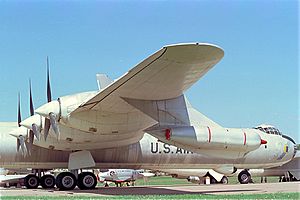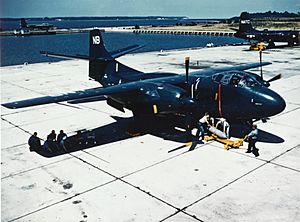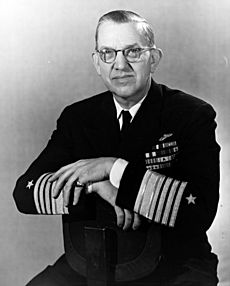Revolt of the Admirals facts for kids
The "Revolt of the Admirals" was a big disagreement in the United States government in 1949. It happened during the Cold War and involved many top Navy officers, both retired and still serving. These included important admirals like Louis E. Denfeld and Gerald F. Bogan, along with famous World War II leaders like Chester W. Nimitz and William Halsey.
At this time, President Harry S. Truman and his Secretary of Defense, Louis A. Johnson, wanted to spend less money on the military. This meant big cuts for the Navy. They believed the United States Air Force and nuclear bombs should be the main way to protect America. The Navy wanted to have a role in strategic bombing too, but the Air Force saw that as their job.
This debate grew from simple disagreements about military plans into a bigger question about who should control the military: civilian leaders or military officers. The government decided to cancel a new aircraft carrier called the USS United States. There were also accusations that Secretary Johnson had done something wrong when buying the Convair B-36 Peacemaker bomber. These issues led to an investigation by the United States House Committee on Armed Services.
Even though the government's side won the argument, the start of the Korean War in June 1950 showed that relying only on nuclear weapons was not enough. Many of the planned cuts to regular military forces were later reversed.
Contents
How the Military Changed After World War II
Bringing the Armed Forces Together
After World War II, the US government wanted to reorganize the military. During the war, the President had special powers to do this, but these powers were ending. So, in 1944, Congress started thinking about new laws for how the military should be set up.
The top military leaders, called the Joint Chiefs of Staff, decided they needed to suggest a plan. They formed a special committee led by Admiral James O. Richardson.

In 1945, this committee suggested combining the War Department (Army) and the Navy Department into one big department. This new department would be led by a civilian secretary. They also suggested creating an independent air force. During the war, the United States Army Air Forces (USAAF) had become quite independent. They really wanted to be a full, separate military branch, just like the Army and Navy.
Many senior Navy officers, including Fleet Admirals William D. Leahy, Ernest J. King, and Chester W. Nimitz, thought these ideas were too extreme. They didn't like the idea of one single Secretary of National Defense. They felt it was too much power for one person. They also worried it would reduce the Navy's influence. A big fear was losing control of their Navy air arm, like what happened to the British Navy's air force when the Royal Air Force was created.
Eventually, a new law called the National Security Act of 1947 was passed. This law created the United States National Security Council (NSC) and the Central Intelligence Agency (CIA). It also made the United States Air Force (USAF) an independent branch. Most importantly, it created the National Military Establishment with a cabinet-level Secretary of Defense to oversee all the military branches. The Navy kept control of its own air forces, including the Marine Corps Aviation. This law seemed to settle the debate, even though no service was completely happy.
James Forrestal, who had fought against the idea of unification, became the first Secretary of Defense. He hoped that with the military branches now unified, they would stop their disagreements.
Money and Military Plans
After World War II, the US government was worried about how much money it had spent during the war. They wanted to reduce spending. So, the military had to quickly shrink back to a peacetime size. Defense budgets dropped a lot. For example, in 1945, the budget was $81 billion, but by 1948, it was only $9 billion.
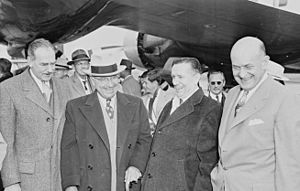
The US also made war plans in case of a conflict with the Soviet Union. It was thought that the Soviet Union probably wouldn't start a war, but plans were made just in case. The Soviet Union had many more soldiers in Europe than the US. Because of this, military planners felt the US had to rely on a strategic air attack using both regular and nuclear weapons.
Admiral Louis E. Denfeld, who became the Chief of Naval Operations in 1947, thought this war plan had many problems. He believed abandoning Western Europe was wrong. Also, the plan relied on using a distant area (Karachi) as a base for air attacks, which would be very hard to supply. He felt there was no backup plan if the air attacks failed. He only agreed to the plan as a temporary solution.
Strategic Bombing Ideas
Before World War II, the US Army Air Corps developed the idea of strategic bombing. This meant using airplanes to bomb enemy factories and cities to destroy their ability to fight. But during World War II, this idea had problems. Bombers flying alone were easily shot down. Also, it was hard to bomb accurately from high altitudes.
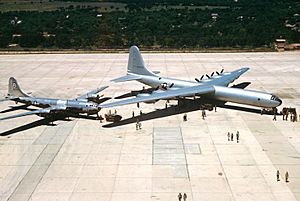
The invention of nuclear weapons made people think strategic bombing could be much more effective. Some believed that if all important parts of an enemy's economy were destroyed at once, they wouldn't be able to recover.
In 1948, the US had parts for about 50 "Fat Man" and two "Little Boy" nuclear bombs. Only special Boeing B-29 Superfortress bombers could carry these weapons. But many target cities in the war plan were too far for the B-29 to reach and return. Also, the B-29 was a propeller plane, making it easy for new Soviet jet fighters to shoot down.
The Convair B-36 Peacemaker bomber was introduced in 1948. It was designed to fly very long distances. It was a huge plane, much bigger than the B-29. Even though it was a piston-engine plane in the age of jets, it was seen as a temporary solution until the jet Boeing B-52 Stratofortress was ready.
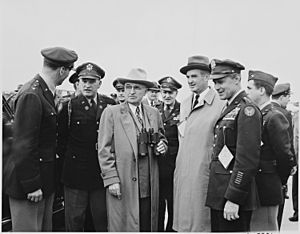
In 1948, the military branches started planning their budgets for 1950. The Air Force wanted $8 billion, but then increased their request to $11 billion when they heard budgets would be cut. All the services together asked for $29 billion.
However, President Truman decided to set a limit of $14.4 billion for defense spending in 1950. This meant the Air Force had to cut back its plans. The Air Force decided to focus on its Strategic Air Command with 14 bomber groups. Its commander, Curtis LeMay, said that four groups should have B-36s because they could reach most targets in the Soviet Union from North America. The B-36 program actually benefited from these cuts, as money from other canceled aircraft orders was used to buy more B-36s.
After World War II, the Navy didn't have a clear plan for its future. Before the war, its main job was to control the seas and destroy enemy fleets. But the Soviet Union had a small navy and didn't rely on sea trade. This meant the Navy's traditional role was less important. The Navy also found itself getting less money than the Army and Air Force, which was a big change.
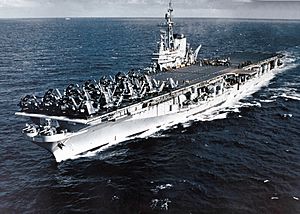
The US Navy got its first aircraft carriers in 1922. Carriers were used to scout, observe, and attack enemy ships. Naval aviators (pilots) were an important part of the Navy, but they always saw themselves as Navy officers first.
One idea for the Navy's role in a conflict with the Soviet Union was to take part in strategic bombing. In 1947, Admiral Daniel V. Gallery wrote a secret memo. He suggested building bombers that could be launched from aircraft carriers, even if they had a shorter range. He argued that a carrier could be sent quickly to a crisis area and didn't need expensive overseas bases. Gallery even thought that strategic bombing with nuclear weapons should be the Navy's main mission.
However, this idea had problems in 1948. Nuclear bombs were very large and heavy. No Navy aircraft could carry the widest bombs. Some planes, like the Lockheed P2V Neptune, could carry smaller nuclear bombs and take off from large carriers with help from rockets. But landing back on the carrier was very difficult and was never tried with a nuclear-capable plane. This meant a one-way mission, losing the plane and crew. A better aircraft, the North American AJ Savage, was being developed.
Secretary of Defense Forrestal believed no single military branch should have all the nuclear weapons. In March 1948, he held a meeting where it was decided that the Air Force would be primarily responsible for strategic bombing, but the Navy could still participate. Many Navy leaders doubted that wars could be won by bombing alone. Some also felt it was wrong to rely on destroying major cities with nuclear weapons. They thought atomic bombs were better used against targets like submarine bases. The Navy's main goal was to show that its air power was still needed.
The USS United States is Canceled
Since 1945, the Navy had been designing a new type of aircraft carrier. Admiral Marc Mitscher was a strong supporter of this new ship. He wanted a "flush deck" carrier, meaning it would have a flat deck without a large island structure. This would allow it to operate 16 to 24 large bombers. It would also be safer from nuclear explosions.
This new carrier, called Project 6A, would be very large, earning it the nickname "supercarrier". The Navy planned to build four of these ships. The first one was approved in 1947 and named the USS United States. Its construction began on April 23, 1949.
President Truman was upset with Secretary of Defense Forrestal for not supporting his election campaign. So, on March 2, 1949, Truman announced that Louis A. Johnson would replace Forrestal. Johnson had helped Truman's campaign by raising a lot of money. Johnson strongly supported Truman's military budget cuts and favored the Air Force's plans. He believed in giving orders and having them followed immediately. When Navy officers questioned his decisions, he saw it as insubordination.

On April 23, 1949, Johnson canceled the construction of the USS United States. President Truman agreed with this decision. This ship was a symbol of the Navy's future, and its cancellation greatly lowered morale. The Secretary of the Navy, John L. Sullivan, resigned in protest. Johnson's decision helped him meet his budget goals and showed he was in charge.
To replace Sullivan, Johnson chose Francis P. Matthews, a lawyer who admitted he had little naval experience. Another change was that Admiral Arthur W. Radford left his post and was replaced by Vice Admiral John D. Price. On August 10, Truman signed changes to the National Security Act, creating the new position of Chairman of the Joint Chiefs of Staff. General Omar Bradley was appointed to this role.
A Navy research group had been collecting information to defend the Navy's position, including details that criticized the B-36 bomber. In April 1949, a secret paper, known as the "Anonymous Document," appeared. It claimed that before becoming Secretary of Defense, Johnson had been on the board of directors for Convair, the company that made the B-36. The document suggested this was a conflict of interest. It also called the B-36 a "billion-dollar blunder" and claimed there was "fraud" regarding its costs and abilities. This document was sent to members of Congress.
Congressional Hearings Begin
At first, Congress didn't seem interested in investigating the "Anonymous Document." But Carl Vinson, the head of the United States House Committee on Armed Services, was concerned about the Navy and Air Force constantly trying to get good publicity, especially when secret information was leaked.
On May 25, 1949, Congressman James Van Zandt called for an investigation into military contracts. Vinson then proposed his own investigation into the B-36 procurement. The House of Representatives approved Vinson's plan on June 8.
The first part of the investigation, called "Unification and Strategy," happened in August 1949. It focused on the claims of fraud from the "Anonymous Document." The author was found to be Cedric R. Worth, a former Navy commander. Worth testified, but the committee found no evidence of wrongdoing by Johnson or Symington. The Air Force was cleared of all charges. The committee recommended that Worth be fired, which he was. This was embarrassing for the Navy.
When a Navy pilot named Captain John G. Crommelin heard about proposed Navy budget cuts, he held a press conference. He claimed that combining the military branches was a mistake and that Johnson wanted to destroy the Navy. Admiral Denfeld didn't directly respond, saying Navy officers were free to express their opinions. But Secretary Matthews disagreed and transferred Crommelin to a less important job. Matthews and Denfeld then issued a rule that all public speeches and articles by Navy personnel had to be approved by the Secretary of the Navy.
Admiral Bogan, a Navy commander in the Pacific, wrote to Secretary Matthews in September. He said that Navy morale was "lower today than at any time since I entered the commissioned ranks in 1916" and supported Crommelin's views. Denfeld agreed with Bogan's feelings in his own endorsement of the letter.
A second hearing began in October. It focused on the Navy's budget cuts, the cancellation of the USS United States, and the plans to expand strategic bomber forces. These hearings became even more urgent when President Truman announced on September 23 that the Soviet Union had tested its first nuclear bomb. Secretary Matthews promised that no Navy person would be punished for their testimony.
However, when the hearings started on October 6, Navy officers did not support Secretary Matthews. Instead, many officers testified that the Air Force's reliance on the B-36 was not good enough. They also said that the whole idea of atomic bombing was wrong. Famous World War II Navy leaders like Fleet Admirals Ernest King, Chester Nimitz, and William Halsey testified. Admiral Arleigh Burke showed that the Navy already had a fighter jet, the F2H Banshee, that could fly high enough to intercept bombers like the B-36. This meant the B-36 would need fighter escorts, which the Air Force didn't have. Admiral Denfeld generally supported the Navy officers who testified.
On October 18 and 19, Symington and Vandenberg from the Air Force responded to the admirals' testimony. Vandenberg said he didn't see a need for the USS United States in any plan against the Soviet Union. Symington denied that the Air Force wanted to bomb civilians or believed in a "quick, easy and painless war" with atomic bombs. Vandenberg said that during World War II, bombers always reached their targets, and technology had improved since then.
Other important people like former President Herbert Hoover, Secretary Johnson, and Generals George Marshall, Dwight D. Eisenhower, and Omar Bradley also testified about the benefits of military unification. General Bradley famously said that large-scale amphibious operations, like those in Sicily and Normandy, would "never occur again." He criticized the Navy's actions and accused senior Navy officers of disloyalty.
The House Armed Services Committee found that some actions by the government and military branches went too far. They said that evaluating weapons should be done by a special group, not by individual services judging each other's weapons. They questioned whether Army and Air Force leaders were qualified to decide what ships the Navy needed. The committee criticized Johnson for canceling the carrier so quickly without talking to Congress. They said that national defense involves Congress and the American people, not just the executive branch. The committee supported unification but said it was happening "too fast."
During the hearings, public opinion turned against the Navy. The whole event became known as the "Revolt of the Admirals."
What Happened Next
After the hearings, Secretary Matthews started punishing the Navy officers who had testified, even though he had promised not to. Admiral Denfeld was removed from his position by President Truman on October 27, 1949. Matthews said they disagreed on military policy. Denfeld decided to retire instead of taking another job. Matthews chose Admiral Forrest Sherman as the new Chief of Naval Operations. Admiral Bogan was given a less important command and also chose to retire. Captain Crommelin continued to speak out and was forced to retire by Sherman.
One of Sherman's first actions was to close down the Navy research group that had gathered information against the B-36. Matthews and Johnson tried to stop Admiral Burke from being promoted, but Truman reversed their decision. The House Armed Services Committee criticized Denfeld's removal, saying it was punishment for his testimony and went against promises made to witnesses.
The Truman administration won the conflict with the Navy, and it was made clear that civilian leaders were in charge of the military. After the hearings, military budgets focused on developing more Air Force heavy bombers.
On June 25, 1950, the Korean War started. The Truman administration had to deal with the crisis using the forces they had. They decided not to use nuclear weapons and tried to stop the North Korean advance with regular forces. The war showed that relying only on nuclear weapons was not enough. It also proved right those who had called for more defense spending. Truman was surprised to learn that the Navy didn't have enough warships to carry out a naval blockade of North Korea. Facing public criticism for how the war was going, Truman asked for Johnson's resignation in September 1950. He then nominated George Marshall as Secretary of Defense.
The Korean War forced Truman to spend more money on defense. Defense spending quadrupled between 1950 and 1953. The Army grew, the Navy increased its carrier force, and the Air Force expanded.
The Navy did eventually get a supercarrier. Johnson approved its construction on June 22, 1950. The USS Forrestal, launched in 1955, was much larger than previous carriers. It had a strong, angled flight deck that could handle heavy bombers carrying small nuclear bombs. It also had steam catapults to help the heavy planes take off. Later, as nuclear weapons became smaller, standard Navy attack planes could carry them.
See also
 In Spanish: Revuelta de los Almirantes para niños
In Spanish: Revuelta de los Almirantes para niños


